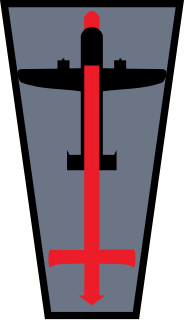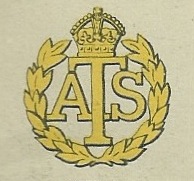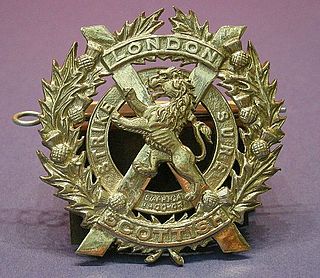
The 1st Anti-Aircraft Division was an Air Defence formation of the British Army before and during the early years of World War II. It defended London during the Battle of Britain and The Blitz.
26th (London) Anti-Aircraft Brigade was an Air Defence formation of the British Army during World War II. It defended London during the Blitz.

93rd Searchlight Regiment, Royal Artillery was an all-female British air defence unit during World War II, formed in October 1942 and disbanded in July 1945.
The 38th Light Anti-Aircraft Brigade was an air defence formation of Britain's Territorial Army formed just before World War II, which protected London and Southern England during the Blitz and later converted into an infantry formation for the liberation of Europe.

The 79th Heavy Anti-Aircraft Regiment, Royal Artillery was an air defence unit of Britain's Territorial Army (TA). Formed just before World War II, it fought in the Battle of France, the Swansea Blitz, Operation Torch and the Italian Campaign. It continued serving in the post-war TA until 1955.
The 41st (London) Anti-Aircraft Brigade was an air defence formation of Anti-Aircraft Command in the British Territorial Army, formed shortly before the outbreak of World War II. Its role was to defend East Anglia.
The 86th Heavy Anti-Aircraft Regiment, Royal Artillery was an air defence unit of Britain's Territorial Army (TA) that served throughout World War II. It defended London during The Blitz, landed on Juno Beach on D-Day, and defended the cities of Belgium against V-1 flying bombs.

1st Anti-Aircraft Group was a formation created by the British Army's Anti-Aircraft Command in 1942 to control anti-aircraft (AA) units defending London against Luftwaffe attacks during World War II. It continued this role into the Cold War until disbandment in 1955.

97th Heavy Anti-Aircraft Regiment, Royal Artillery, was an air defence unit of Britain's Territorial Army (TA) formed during the period of international tension leading up to the outbreak of World War II. It was raised as a duplicate battalion by the famous London Scottish Regiment. The unit defended London during The Blitz and then served in Sicily and Italy, both in the anti-aircraft (AA) and medium artillery roles. The regiment continued in the postwar TA until amalgamated in 1955.

139th (Mixed) Heavy Anti-Aircraft Regiment was an air defence unit of Britain's Royal Artillery formed during World War II. It was one of the first 'Mixed' regiments in which women of the Auxiliary Territorial Service were integrated into the unit's personnel. It defended West Yorkshire and the North Midlands against aerial attack until it became the first Mixed anti-aircraft (AA) unit to serve overseas, defending Brussels against V-1 flying bombs.

131st Heavy Anti-Aircraft Regiment was an air defence unit of Britain's Royal Artillery formed during World War II. It was organised as the first 'Mixed' regiment in which women of the Auxiliary Territorial Service were integrated into the unit's personnel, though it later reverted to an all-male organisation. It defended the United Kingdom against aerial attack for two years.

132nd (Mixed) Heavy Anti-Aircraft Regiment was an air defence unit of Britain's Royal Artillery formed during World War II. It was one of the first 'Mixed' regiments in which women of the Auxiliary Territorial Service were integrated into the unit's personnel. It defended London and South-East England against aerial attack until it deployed to Belgium in January 1945 to defend Brussels against V-1 flying bombs.

137th (Mixed) Heavy Anti-Aircraft Regiment was an air defence unit of Britain's Royal Artillery formed during World War II. It was one of the first 'Mixed' regiments in which women of the Auxiliary Territorial Service were integrated into the unit's personnel. It defended the United Kingdom against aerial attack until it deployed to Belgium in January 1945 to defend Brussels against V-1 flying bombs.

155th (Mixed) Heavy Anti-Aircraft Regiment was an air defence unit of Britain's Royal Artillery formed during World War II. Around two-thirds of its personnel were women from the Auxiliary Territorial Service (ATS). After defending the West of Scotland and later London, the regiment was heavily engaged in Operation Diver against V-1 flying bombs, and later was deployed to Antwerp to carry out anti-Diver duties there in the closing stages of the war.

183rd (Mixed) Heavy Anti-Aircraft Regiment was an air defence unit of Britain's Royal Artillery formed during World War II. Around two-thirds of its personnel were women from the Auxiliary Territorial Service (ATS). The regiment was heavily engaged in Operation Diver, defending England against V-1 flying bombs, and later was deployed to Antwerp to carry out anti-Diver duties there in the closing stages of the war.

143rd Heavy Anti-Aircraft Regiment was an air defence unit of Britain's Royal Artillery formed during World War II. It started out as a 'Mixed' regiment with around two-thirds of its personnel being women from the Auxiliary Territorial Service (ATS). The regiment defended the West of England from 1942 to the end of the war when it moved to South East England. The regiment continued in the postwar British Army.

98th Heavy Anti-Aircraft Regiment, Royal Artillery, was an air defence unit of Britain's Territorial Army (TA) formed in Gloucestershire during the period of international tension leading up to the outbreak of World War II. It defended aircraft factories during the Battle of Britain, then the city of Manchester during the Blitz. It later served in the campaign in North West Europe. The regiment continued in the postwar TA until amalgamated in 1955.

163rd (Mixed) Heavy Anti-Aircraft Regiment was an air defence unit of Britain's Royal Artillery formed during World War II. Around two-thirds of its personnel were women from the Auxiliary Territorial Service (ATS). The regiment defended London, operating the heaviest guns serving with Anti-Aircraft Command.

79th Searchlight Regiment, was an air defence unit of Britain's Royal Artillery during World War II. It protected London and South East England as part of Anti-Aircraft Command from the Blitz of 1940 until Operation Diver in 1944, after which it was disbanded.

117th Heavy Anti-Aircraft Regiment was an air defence unit of Britain's Royal Artillery during World War II. It protected Sheffield during the latter part of The Blitz and also served on Merseyside and in the Orkneys, where it protected the vital naval base of Scapa Flow. Later it defended London during the 'Baby Blitz' and against the V-1 flying bomb offensive. Towards the end of the war the regiment was converted into infantry for occupation duties in Continental Europe. It was disbanded at the end of the war.











